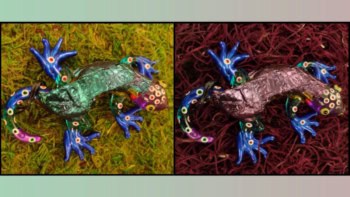
A new type of optical fibre that can carry “twisted” light over long distances has been developed by researchers in the US, Israel and Denmark. Their “vortex fibre” and associated encoding and decoding technologies allow data to be transmitted using the orbital angular momentum (OAM) states of light. In principle, the system could be used to increase the rate at which information can be sent along an optical fibre – and could ultimately boost the data-traffic capacity of the Internet.
As more information is sent across the Internet, researchers are looking for new ways of boosting the data capacity of the optical fibres that carry digital communications. While there are several new schemes under development, they all have drawbacks, such as the need for intensive signal processing or complicated multicore fibres.
Recently, scientists have shown that information can be encoded into the OAM of light. Light with OAM has a wavefront that rotates around the propagation axis, creating a spiral or vortex. By contrast, an ordinary light beam has a wavefront with an orientation that remains fixed with respect to its direction of propagation.
Coupling problems
In principle, OAM could be combined with conventional multiplexing techniques to boost the rate at which data can be transmitted along optical fibres. A major problem, however, is that even the slightest bend, twist or temperature variation in a fibre can cause light in one OAM transmission mode to jump into other modes. This coupling of modes leads to the rapid loss of information and it was only possible to send OAM-encoded data less than a metre along conventional fibres.

A new system that gets around this problem has been created by Siddharth Ramachandran and colleagues at Boston University, Alan Willner’s group at the University of Southern California (USC), researchers at Tel Aviv University and the fibre-maker OFS-Fitel, Denmark.
According to Ramachandran, who led the development of the fibre, the new system is designed so that the phase velocities of the OAM modes are different. This minimizes the probability of coupling between modes as the signals propagate along the fibre.
Circle and ring
At the centre of their new fibre is a region about 8 μm in diameter that comprises an inner circle and a concentric ring (see figure “Cross-section of the vortex fibre”). Both of these regions have indices of refraction that are greater than the rest of the fibre. This fibre is designed to carry four distinct modes – two zero-OAM modes that propagate in the inner circular core and two OAM modes that propagate in the outer ring. As well as minimizing the coupling of light between the zero-OAM and OAM modes, the design also reduces coupling between the OAM modes and two other “parasitic” modes that could occur in a fibre.
About 1.1 km of the fibre was manufactured by OFS-Fitel. “We were intent on showing this to work only with fibres that could be produced in a real production environment and all the fabrication steps we used were identical to those used in commercial producing optical fibres,” explains Ramachandran.
Development of the system that encodes and decodes the OAM pulses was led by Willner at USC. Dubbed OAM mode-division multiplexing (OAM-MDM), the system encoded data into four separate channels. These are defined in terms of the OAM (0 or 1) and circular polarization (–1 or 1) of the light. Using just these four modes, the team was able to transmit data over a 1.1 km fibre at a rate of 400 Gbit/s.
Eight Blu-rays per second
The system was also able to reproduce each quartet of OAM modes at 10 different wavelengths of light – a technique called wavelength-division multiplexing (WDM). This boosted the transmission rate to 1.6 Tbit/s – the equivalent of transmitting eight Blu-ray discs every second. While such data rates are routinely achieved by commercial WDM systems, this is the first time that OAM-based transmission has been achieved over distances greater than a metre.
Ramachandran believes that the transmission could be further boosted by minimizing losses in the system. “The one good thing about having started with fibre fabricated on a real production line is that it gives us hope that, where/when OAM supporting fibres are needed, our approach would have already addressed the manufacturability issue,” he adds.
The system is described in Science.



